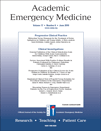Critical Care Ultrasonography
Critical Care Ultrasonography . By , , . New York : McGraw Hill , 2009 ; 400 pp; $175 (hardcover ).
The authors of Critical Care Ultrasonography have set their aim at creating a comprehensive guide to the use of bedside sonography in the intensive care unit (ICU). The text presents a broad range of topics, spanning initiation of an ultrasound (US) program, to machine maintenance and clinical application of the technology. The majority of the text focuses on an extensive list of clinical applications from transesophageal echocardiography to transvaginal US. The breadth of each topic is wide, with critical discussion of clinical applications included in many chapters. This text includes 30 chapters in four sections, a supporting DVD with video clips, and an appendix of draft US reports.
The first section includes five chapters that discuss the administrative aspects of an US program in the intensive care setting. Chapter 1 encompasses a thoughtful discussion of the potential effects of US on patient care in the ICU. The author discusses the concepts of structure, process, and outcome in the approach to new technology. An intense and comprehensive discussion of the physics and mechanics of US comprises Chapters 2 and 3. A global perspective on the training of intensivists in US is presented in Chapter 4. The final chapter in the first section supplies a focused look at US in pediatric critical care.
Section 2 provides an expansive look at echocardiographic evaluation of the heart. Both transesophageal and transthoracic echocardiography are discussed. The initial chapter sets the stage with a nice discussion of the utility and feasibility of echocardiographic evaluation of the critically ill patient. The chapters vary in author style, but overall a critical approach to the literature and clinical application to the patient is the theme of this section. The use of diagrams of anatomy and examples of transducer placement vary by author, as do image quality. The discussions address the complex, multidimensional, critically ill patient, embracing the applications as well as limitations of US in this arena. This reader reveled in the intense discussion of the evaluation of the critically ill patient with US.
Section 3 constitutes a broad array of US imaging techniques, as evidenced by the title, “Ultrasound of the Neck, Trunk, and Extremities.” The expanded scope of this section gives the reader an overview of the true breadth of US, including pelvic sonography and visualization of the paranasal sinuses. Chapter 26, “Ultrasound Evaluation of the Peripheral Vascular System,” is notable for excellent diagrams and images. The thorough nature of this section ensures that the reader will gain the knowledge to address any clinical scenario with US.
The final section addresses procedural US, with a nice mix of common and less common procedures. Chapter 29, “Peripheral and Neuraxial Blocks,” presents an overview of nerve blocks that can be performed by US guidance. The vascular access chapter, “Chapter 30,” gives the reader a nice plethora of visual images to clarify the reading. There is supporting video on the DVD in the pediatric section.
A dynamic imaging modality such as US requires dynamic teaching, as is provided in the accompanying DVD. The clips are generally of excellent quality, although all of the clips would benefit from increased labeling or voice-over to improve reader understanding of the visualized anatomy and pathology. It primarily includes cardiac videos; however, the pediatric section covers some additional procedural topics, and there are two nice sections on lung pathology. The DVD addresses a necessary aspect of learning to perform US.
This text provides an exhaustive discussion of US in critical care. The reader is exposed to a wide scope of topics, including administration and start-up of an US program, fundamental image acquisition techniques, and complex concepts in application. The majority of emergency physician sonographers will find the most benefit in the intense discussion of echocardiography in the critically ill patient provided in Section 2. This complete text will serve as a reference guide for department chairs and a clinical guide for novice and experienced clinicians.




